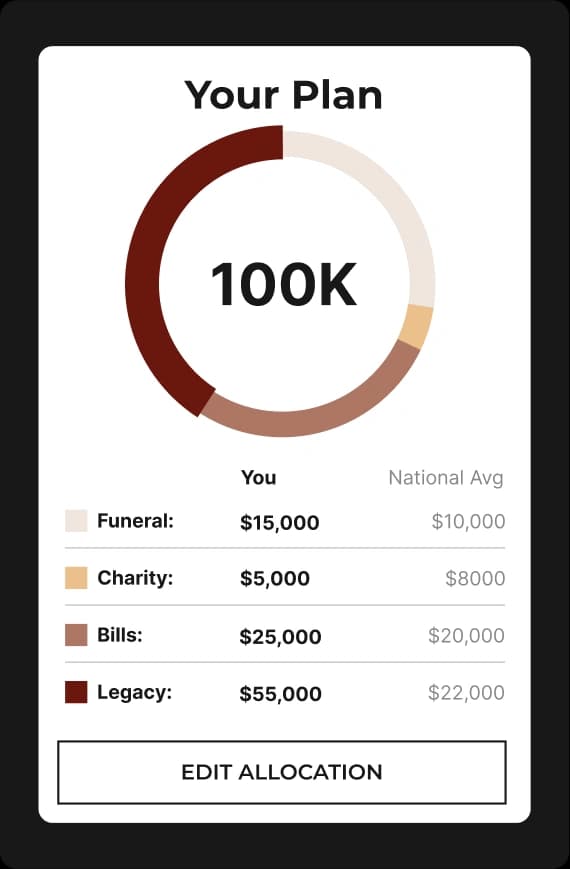Medicaid for Long-Term Care: What Is Covered?
SHARE THIS
Did you know that the average nursing home in the United States costs $275 per day?
This translates to around $8,365 per month. While this is the average price in 2023, the costs have steadily been on the rise and will continue to rise every year. This is why it’s so important for young seniors to plan for the future, especially when it comes to medical and long-term care costs.
There are benefits to Medicaid for long-term care. However, it’s important to understand exactly what Medicaid covers and its limitations. Having this knowledge is vital in helping you plan your future finances.
Read on for a complete overview of what’s included in Medicaid, and the alternatives available to help you create a good financial plan.

Need Long-Term Care Protection?
Our innovative term life insurance solution includes powerful built-in living benefit features designed to give you access to money for long-term care. It includes:
- Long-Term Care Protection
- Nursing Home Protection
- Terminal Illness Protection
There are no medical exams required and you can purchase your coverage today - 100% online.
How Does Medicaid for Long-Term Care Work?
Medicaid is a joint healthcare program that’s administered by both the state and federal governments. This means that half the funds are directly from the federal government while the state is responsible for the other half. While strict rules and regulations exist to maintain federal funding, states do have the freedom to administer their half of the funds however they want as long as they maintain the federal guidelines, otherwise, federal money can be cut off.
Medicaid is the largest public payer of long-term care services in the United States, but those services come with strict eligibility requirements. These requirements are set to make sure that funds are going to those in desperate need of medical care that they can’t afford. To qualify you need to have little to no income or assets, be over the age of 65, and suffer from a permanent disability or blindness.
Medicaid covers a wide range of long-term care services for the elderly including nursing homes and custodial care, services that are provided at home such as visiting nurses, and assistance with personal care. Another benefit is community-based services, these include personal care services like laundry, cleaning support, and case management.
Which Long-Term Care Services Are Covered Under Medicaid
Medicaid covers a wide range of long-term care services. While there are strict requirements, the coverage is substantial and covers both institutional and community-based services. Here’s a quick look at which long-term care services are covered under Medicaid.
Institutional Medicaid
Institutional Medicaid is meant for those that require nursing home level of care. To qualify, a medical specialist will determine if the care they require is in a nursing home or assisted living setting. The criteria to qualify for Institutional Medicaid varies by state but typically qualifying factors include functional or cognitive abilities.
If an individual needs to be placed in a nursing home, the institution used must be a “Medicaid certified nursing facility” in order for Medicaid to cover the costs. The benefit of this is knowing that the care you receive is in line with federal standards.
To qualify for long-term care services from Medicaid, there are strict regulations and eligibility criteria to meet. Only U.S. citizens or those who meet state residency rules qualify for this benefit. In addition to this, you need to be over the age of 65, have a permanent disability, or be blind.
These regulations are not designed to exclude people from care but are rather crafted to ensure that care is provided to those who really need it.
Community Medicaid
Medicaid also covers community-based long-term care services. This means that you can receive assistance for services community-based rather than strictly medical such as in-home care and adult day care for seniors.
When it comes to in-home services, Community Medicaid covers homemaker services such as meal prep, light house cleaning, and companionship. Home health services are like assistance with grooming and bathing included.
While there are regulations and eligibility requirements, Medicaid steps in to cover most of the costs for you. This way you can enjoy a good quality of life as you get older and need more assistance.
In Which Facilities Can Care Be Provided?
When it comes to getting the care you need, it’s important to understand what facilities are covered by Medicaid. These services can range from state to state but must all abide by federal standards and regulations. This way, you know that you’re getting excellent care from a facility that has the certifications required by the federal government.
Here’s a quick look at which facilities and care are covered by Medicaid.
Nursing Home
Medicaid can be incredibly helpful if you ever need to be placed in a nursing home. Medicaid covers a majority of the costs associated with care in an LTC facility like a nursing home as long as you meet the strict financial eligibility requirements.
Medicaid covers 100% of the cost for nursing home care and will pay out the fixed daily rate so you don’t have to pay any part of the expenses. The costs Medicaid pays for includes care, social services, room and board, meals, and personal hygiene items that you may need.
In-Home Care
Medicaid also covers a wide range of in-home care services for the elderly. When it comes to in-home care, there are both financial criteria and functional criteria that need to be met. This basically states that you’re unable to travel to a long-term care facility to get the care that you need.
Home care services include basic assistance that you may need for daily living. This includes mobility, bathing, dressing, eating, and toiletry. These services can also include instrumental activities such as shopping, laundry, and light house cleaning.
If you need medical care, skilled nurses can come to your home to provide you with the care you need. This helps you get excellent care without having to worry about mobility issues that you may have. While there may be a small co-pay for some services, the exact structure can vary from state to state.
Assisted Living Facility
Assisted living facility guidelines can vary from state to state. However, Medicaid does have federal regulations that ensure all facilities abide by federal standards. These services include LTC facilities with medical staff to community centers such as adult day cares.
Others
Medicaid goes above and beyond to provide you with the care that you need. This means that seniors can receive benefits even if you require care in someone else’s home or wish to go to an adult daycare. While each state does have its own requirements and eligibility criteria, Medicaid does cover a majority of the costs.
Medicaid Long-Term Care Eligibility
When it comes to qualifying for long-term care from Medicaid, there are a few requirements to keep in mind. Here’s a quick look at the Medicaid eligibility requirements for long-term care.
General Requirements
The basic requirements to qualify for long-term care from Medicaid are that you need to be a U.S. citizen or be recognized as a resident in your state. Additionally, you should be at least 65 years old or have a permanent disability or blindness to qualify.
Medical Requirements
When it comes to the medical requirements, the regulations can vary from state to state. In most cases, a letter from a doctor or medical professional outlining your need for care is enough to qualify for long-term care services.
Financial Requirements
Medicaid is there for people who need care and can’t afford it. Here’s a quick look at the financial requirements for Medicaid.

Income Limits
Income limits vary by state to qualify for Medicaid, however, most have monthly income as high as $2,742 per month for an individual. This means that if you earn under this limit, you’ll qualify for Medicaid benefits. Some states allow people earning more to still qualify by ‘spending down’ their added income.

Asset Limits
The financial requirements are not just about income but are also based on your assets. The general asset limit can vary from state to state but is usually around $2,000. It’s important to note that countable assets exclude your primary residence.
What Is Medicaid Spend-Down?
Medicaid is typically for people with little to no income or assets which prevents them from being able to pay for medical treatments or long-term care that is why there is such a strict income requirement to qualify for Medicaid long-term care. However, even if you find that you are over the income limit - you can still qualify for care by spending the excess income on high medical expenses. Many states will deduct that amount from your income to help you qualify for services provided by Medicaid. It’s important to note that not just anyone is able to “spend down” their income this way. A person must also be either under 21 years old, over 65 years old, blind, or disabled in some other way.
How Much Does Medicaid Pay for Long-Term Care?
The services that Medicaid will pay for vary from state to state and will depend on the care that you need. For example, if you’re in a skilled nursing home, Medicaid will cover the long-term costs as long as you meet the qualifying criteria and the facility is Medicaid certified. When it comes to assisted living facilities, Medicaid will pay for some of the living fees by way of Community Based Services Waivers. They won’t pay for room and board or rent at these facilities but there are programs for Medicaid users that can help.
Each state has their own policies when it comes to Medicaid programs, so it’s important to check with your state for your coverage range.
How Can I Apply for These Benefits?
Applying for Medicaid long-term care varies by state but there are a series of steps you can take to make the process a little bit easier.
- Identify the type of Medicaid LTC you want to apply for such as Nursing Home, Community Based Services or Age, Blind or Disabled Medicaid.
- Determine if you are automatically eligible for benefits.
- Gather supporting documentation for the application such as financial statements, social security information, tax documents, health insurance documentation, etc.
- Locate your local Medicaid office for the application process.
- Complete the application.
- Review your determination letter regardless if you have been approved or denied benefits as they could contain errors.
Taking the time to understand the process and making sure you have everything you need ahead of time will help to make applying for Medicaid long-term care a little less burdensome.
What if I Don’t Qualify for Medicaid?
If you don’t qualify for Medicaid, there are a few other options you can use to get the care that you need. This includes using your personal savings or investing in long-term care insurance.
Another way to ensure the high costs of long-term care are covered is by investing in long-term care insurance.
In addition to traditional long-term care insurance policies that help pay for services like nursing home care, in-home care, assisted living, there are alternative insurance policies that can also provide significant financial support for seniors when it comes to long-term care.
For example, there are life insurance policies that include special built in features that will allow you to access your policy to help pay for long-term care costs if you need them. They are known as accelerated death benefit riders and allow you to leverage your policy while you are still alive. And if you don’t need to access these features, you can designate the policy benefit to go to a loved-one after you die.
Bottom Line
There are major benefits of Medicaid for long-term care. However, there are still limitations that could make long-term care expensive if you can’t afford the co-pays. This is why private insurance should also be an important consideration.
Our content is created for educational purposes only. This material is not intended to provide, and should not be relied on for tax, legal, or investment advice. Everdays encourages individuals to seek advice from their own investment or tax advisor or legal counsel.






